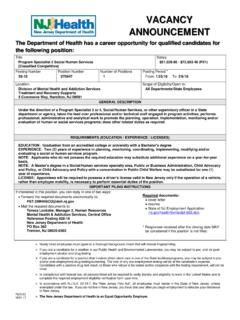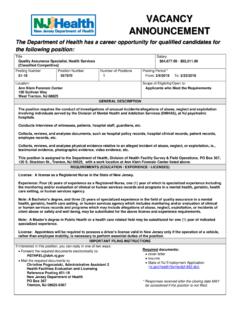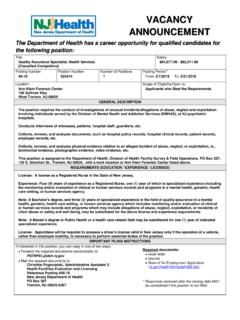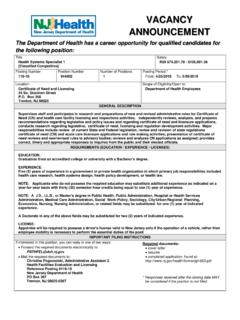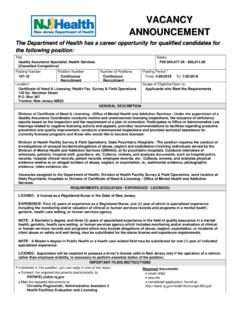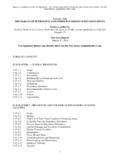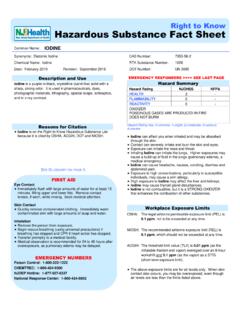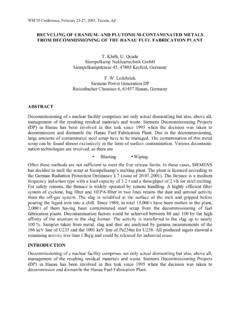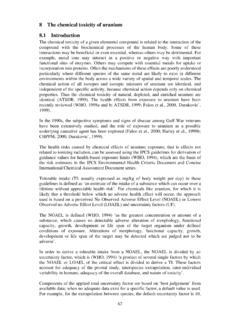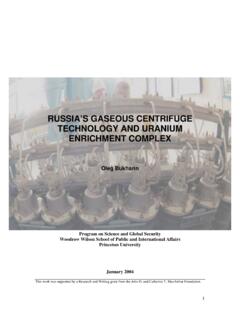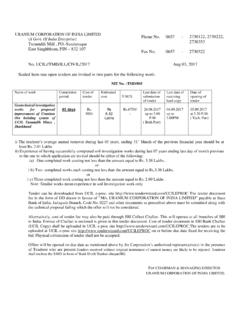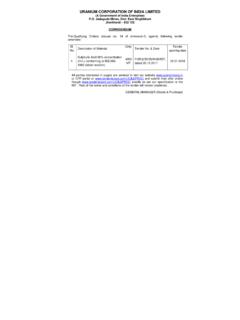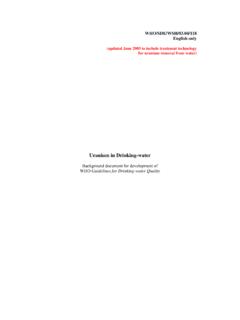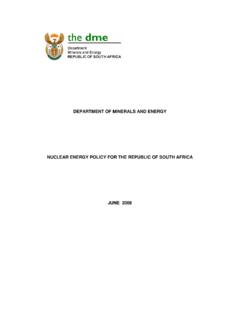Transcription of URANIUM HEXAFLUORIDE HAZARD SUMMARY …
1 Common Name: URANIUM HEXAFLUORIDE CAS Number: 7783-81-5 DOT Number: UN 2977 (greater than 1% U-235) UN 2978 (low specific activity) ---------------------------------------- --------------------------------- HAZARD SUMMARY * URANIUM HEXAFLUORIDE emits radioactive particles which can be breathed in, swallowed or can penetrate the skin. * URANIUM HEXAFLUORIDE is RADIOACTIVE. Ionizing radiation can cause mutations, cancer and/or reproductive damage. * URANIUM HEXAFLUORIDE is a HIGHLY CORROSIVE CHEMICAL and contact can severely irritate and burn the skin and eyes with possible eye damage. * Breathing URANIUM HEXAFLUORIDE can irritate the nose, throat and lungs causing coughing, wheezing and/or shortness of breath. * High exposure can cause nausea, vomiting, restlessness, nervousness and convulsions.
2 * URANIUM HEXAFLUORIDE may damage the kidneys. * URANIUM HEXAFLUORIDE is a REACTIVE CHEMICAL. * URANIUM HEXAFLUORIDE is a radioactive isotope and is regulated by the Nuclear Regulatory Commission (NRC). Refer to the NRC Standard 10 CFR 20. * CONSULT THE NEW JERSEY DEPARTMENT OF HEALTH AND SENIOR SERVICES HAZARDOUS SUBSTANCE FACT SHEETS ON URANIUM AND FLUORINE. IDENTIFICATION URANIUM HEXAFLUORIDE is a colorless or white sand-like solid. It is used in the production of URANIUM and as nuclear fuel. REASON FOR CITATION * URANIUM HEXAFLUORIDE is on the Hazardous Substance List because it is regulated by OSHA and cited by ACGIH, DOT and NIOSH. * This chemical is on the Special Health HAZARD Substance List because it is REACTIVE and CORROSIVE.
3 * Definitions are provided on page 5. HOW TO DETERMINE IF YOU ARE BEING EXPOSED The New Jersey Right to Know Act requires most employers to label chemicals in the workplace and requires public employers to provide their employees with information and training concerning chemical hazards and controls. The federal OSHA HAZARD Communication Standard, , requires private employers to provide similar training and information to their employees. RTK Substance number: 1970 Date: December 2001 ---------------------------------------- --------------------------------- * Exposure to hazardous substances should be routinely evaluated. This may include collecting personal and area air samples.
4 You can obtain copies of sampling results from your employer. You have a legal right to this information under OSHA * If you think you are experiencing any work-related health problems, see a doctor trained to recognize occupational diseases. Take this Fact Sheet with you. WORKPLACE EXPOSURE LIMITS The following exposure limits are for soluble URANIUM compounds (measured as URANIUM ): OSHA: The legal airborne permissible exposure limit (PEL) is mg/m3 averaged over an 8-hour workshift. NIOSH: The recommended airborne exposure limit is mg/m3 averaged over a 10-hour workshift. ACGIH: The recommended airborne exposure limit is mg/m3 averaged over an 8-hour workshift and mg/m3 as a STEL (short-term exposure limit).
5 * The above exposure limits are for air levels only. When skin contact also occurs, you may be overexposed, even though air levels are less than the limits listed above. * Exposure to radioactive materials is regulated by the NRC and OSHA. Refer to the NRC Standard 10 CFR 20 and the OSHA Standard 29 CFR WAYS OF REDUCING EXPOSURE * Enclose operations and use local exhaust ventilation at the site of chemical release. If local exhaust ventilation or enclosure is not used, respirators should be worn. * A regulated, marked area should be established where URANIUM HEXAFLUORIDE is handled, used, or stored. * Wear protective work clothing. * Wash thoroughly immediately after exposure to URANIUM HEXAFLUORIDE and at the end of the workshift.
6 * Post HAZARD and warning information in the work area. In addition, as part of an ongoing education and training effort, communicate all information on the health and safety hazards of URANIUM HEXAFLUORIDE to potentially exposed workers. URANIUM HEXAFLUORIDE page 2 of 6 This Fact Sheet is a SUMMARY source of information of all potential and most severe health hazards that may result from exposure. Duration of exposure, concentration of the substance and other factors will affect your susceptibility to any of the potential effects described below. ---------------------------------------- ----------------------------------- HEALTH HAZARD INFORMATION Acute Health Effects The following acute (short-term) health effects may occur immediately or shortly after exposure to URANIUM HEXAFLUORIDE : * Contact can severely irritate and burn the skin and eyes with possible eye damage.
7 * Breathing URANIUM HEXAFLUORIDE can irritate the nose, throat and lungs causing coughing, wheezing and/or shortness of breath. * High exposure can cause nausea, vomiting, restlessness, nervousness and convulsions. Chronic Health Effects The following chronic (long-term) health effects can occur at some time after exposure to URANIUM HEXAFLUORIDE and can last for months or years: Cancer HAZARD * Because URANIUM HEXAFLUORIDE gives off very dangerous radiation, it has the potential for causing cancer. Reproductive HAZARD * Because URANIUM HEXAFLUORIDE gives off very dangerous radiation, it has the potential for causing reproductive damage in humans. Other Long-Term Effects * URANIUM HEXAFLUORIDE may damage the kidneys.
8 MEDICAL Medical Testing If symptoms develop or overexposure is suspected, the following are recommended: * Kidney function tests. Any evaluation should include a careful history of past and present symptoms with an exam. Medical tests that look for damage already done are not a substitute for controlling exposure. Request copies of your medical testing. You have a legal right to this information under OSHA WORKPLACE CONTROLS AND PRACTICES Unless a less toxic chemical can be substituted for a hazardous substance, ENGINEERING CONTROLS are the most effective way of reducing exposure. The best protection is to enclose operations and/or provide local exhaust ventilation at the site of chemical release.
9 Isolating operations can also reduce exposure. Using respirators or protective equipment is less effective than the controls mentioned above, but is sometimes necessary. In evaluating the controls present in your workplace, consider: (1) how hazardous the substance is, (2) how much of the substance is released into the workplace and (3) whether harmful skin or eye contact could occur. Special controls should be in place for highly toxic chemicals or when significant skin, eye, or breathing exposures are possible. In addition, the following control is recommended: * Where possible, automatically transfer URANIUM HEXAFLUORIDE from drums or other storage containers to process containers.
10 Good WORK PRACTICES can help to reduce hazardous exposures. The following work practices are recommended: * Workers whose clothing has been contaminated by URANIUM HEXAFLUORIDE should change into clean clothing promptly. * Do not take contaminated work clothes home. Family members could be exposed. * Contaminated work clothes should be laundered by individuals who have been informed of the hazards of exposure to URANIUM HEXAFLUORIDE . * Eye wash fountains should be provided in the immediate work area for emergency use. * If there is the possibility of skin exposure, emergency shower facilities should be provided. * On skin contact with URANIUM HEXAFLUORIDE , immediately wash or shower to remove the chemical.
